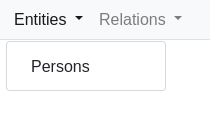Create your ontology
The heart and soul of your APIS application is the ontology. It describes entities and relations.
Given that APIS is based on Django, the file where we describe our entities and relations is the models.py file of your APIS project.
Entities
Entities have to inherit from
apis_core.apis_entities.models.AbstractEntity. Like with any other
Django model, you can define model fields describing the
attributes of this entity. A simple person model could look like this:
from django.db import models
from apis_core.apis_entities.models import AbstractEntity
class Person(AbstractEntity):
name = models.CharField(blank=True, default="", max_length=1024)
apis_core.apis_entities.models.AbstractEntity brings some useful
functionality for Entities, but it also itself inherits from
apis_core.generic.abc.GenericModel, which means that as soon as
you define your models and run
migrations your
models will show up in the APIS webinterface in Entities menu in the
top left corner.
For every entity you defined there will be an overview page that
lists all instances for that entity, as well as a form for creating,
updating, merging and deleting entities.

Relations
To use the relations module, you have to add it to your INSTALLED_APPS. The module
ships with templates that add the relation listing to templates from other apis_core
modules, so we recommend to put the Relations module at the top of the apps list:
INSTALLED_APPS = ["apis_core.relations"] + INSTALLED_APPS
Relations have to inherit from apis_core.relations.models.Relation. You will
have to set the attribute subj_model and obj_model which point
to some Django model (can also be a list of Django models). The Django models can be
specified by their class name or using the natural key of the model
(“APP_NAME.MODEL_CLASS”).
A simple Relation between a person and a place could look like this:
from apis_core.relations.models import Relation
class PersonLivedInPlace(Relation):
subj_model = Person
obj_model = "other_app.place" # defining the obj_model using the natural key notation
You can define the class methods name and reverse_name to provide human readable strings for your relation model. They default to the verbose_name (name) and the verbose_name with the string ` reverse` appended (reverse_name).
from apis_core.relations.models import Relation
class PersonLivedInPlace(Relation):
subj_model = Person
obj_model = Place
@classmethod
def name(self) -> str:
return "lived in"
@classmethod
def reverse_name(self) -> str:
return "had inhabitant"
Now you can create instances of that relation on your entity pages.
Note
This new module does not change any code in the existing datamodel or codebase. This prevents existing projects that use the legacy Triple or TempTriple implementation to break.